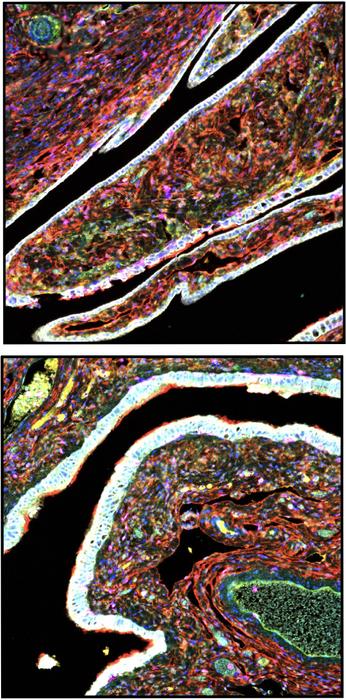Researchers from the University of Pittsburgh have unveiled a groundbreaking discovery that may radically change our understanding of ovarian cancer’s genesis. This pivotal study focuses on a specific subset of mesenchymal stem cells (MSCs) which are observed to play a significant role in the development of high-grade serous ovarian cancer (HGSOC). HGSOC, the most frequently diagnosed type of ovarian cancer, is notorious for its late detection and high mortality rate, claiming the lives of over 12,000 women annually in the United States alone.
Traditionally, the spotlight in ovarian cancer research has been on the epithelial cells that transform into serous tubal intraepithelial carcinoma (STIC) lesions. These lesions can eventually progress to form full-blown tumors. However, researchers led by Dr. Lan Coffman observed that the surrounding stroma, the connective tissue that provides structural support to organs, has been largely overlooked. Their study highlights how these high-risk MSCs, abundant in the stroma of fallopian tubes, might contribute to the onset of cancer rather than merely supporting its progression.
In their groundbreaking research, Coffman and her team have identified that these high-risk MSCs are present even in women without a current cancer diagnosis. Notably, they were more prevalent in those of older age or with genetic mutations, specifically in the BRCA gene, which is known to elevate the risk of developing ovarian and breast cancers. This discovery suggests a crucial link between these progenitor cells and the early stages of cancer initiation, potentially reshaping preventive strategies and diagnosis methods.
The process of how healthy epithelial cells morph into STIC lesions has long puzzled researchers. The team hypothesized that the stroma, enriched with these high-risk MSCs, plays an influential role in this transformation. When these cells are present, they seem to interact with healthy epithelial cells in a way that induces DNA damage and encourages the survival of these damaged cells. This mechanism presents a unique and worrisome cycle that may lead to cancer formation, effectively creating what Coffman describes as “the perfect storm” for ovarian cancer.
A remarkable aspect of their findings is the ability of high-risk MSCs to promote not only cellular transformation but also contribute positively to tumor growth and resistance to chemotherapy. Their work indicates that when these progenitor cells are introduced into patient-derived organoids—miniature 3D tissue cultures—they facilitate a substantial shift in healthy cells towards malignancy. This ability is especially alarming, given that current treatment strategies for ovarian cancer remain limited, with most scientific efforts primarily focused on discovering new systemic therapies that target the tumors directly.
Crucially, the research team identified that these high-risk MSCs exhibit a loss of an important antioxidant, AMP kinase. This loss leads to the overexpression of a protein known as Wilms Tumor 1 (WT1), which activates pathways responsible for producing compounds that damage DNA in the surrounding epithelial cells. The loss of protective antioxidants in the stroma associated with ovarian cancer signifies a pivotal insight into how microenvironmental alterations directly contribute to cancer initiation.
Coffman emphasizes the groundbreaking nature of their findings, marking them as the first evidence indicating a causative role of stromal reconfiguration in the initiation of ovarian cancer. The implications are vast; this research not only opens new avenues for potential therapeutic targets but also sheds light on previously unexplored pathways for early detection. By identifying specific compounds secreted by high-risk MSCs, the potential exists for these markers to be used in routine blood tests as early indicators of ovarian cancer.
With the dire need for improved detection protocols for ovarian cancer, the identification of these biomarkers could dramatically enhance early diagnosis rates, which historically have been dismally low. Timely interventions could lead to significant improvements in patient outcomes, particularly as high-grade serous ovarian cancer often remains asymptomatic until it reaches advanced stages.
The study, detailed in the journal Cancer Discovery, casts a new light on the biology of ovarian cancer, revealing that the interaction between genetic factors, such as BRCA mutations, and the cellular microenvironment is far more complex than previously thought. Given that current preventive strategies are limited to surgical options like castration, understanding the pathways involved in early development becomes even more crucial.
In conclusion, this research provides a robust framework for future studies aimed at delineating the exact mechanisms through which high-risk MSCs influence cancer development. Moreover, it serves as a clarion call to the research community to redirect their focus toward the stromal components of tumors, which may hold the keys to unlocking new prevention strategies and therapeutic approaches.
Subject of Research: Ovarian Cancer Initiation and Progression Through Progenitor Cells
Article Title: Aged and BRCA mutated stromal cells drive epithelial cell transformation
News Publication Date: 14-Mar-2025
Web References: University of Pittsburgh
References: Cancer Discovery
Image Credits: Garcia et al. 2025, Cancer Discovery
Keywords: Ovarian cancer, mesenchymal stem cells, tumor microenvironment, stroma, cancer initiation, BRCA mutations, high-grade serous ovarian cancer, DNA damage, stem cell biology, early detection, cancer biomarkers.




